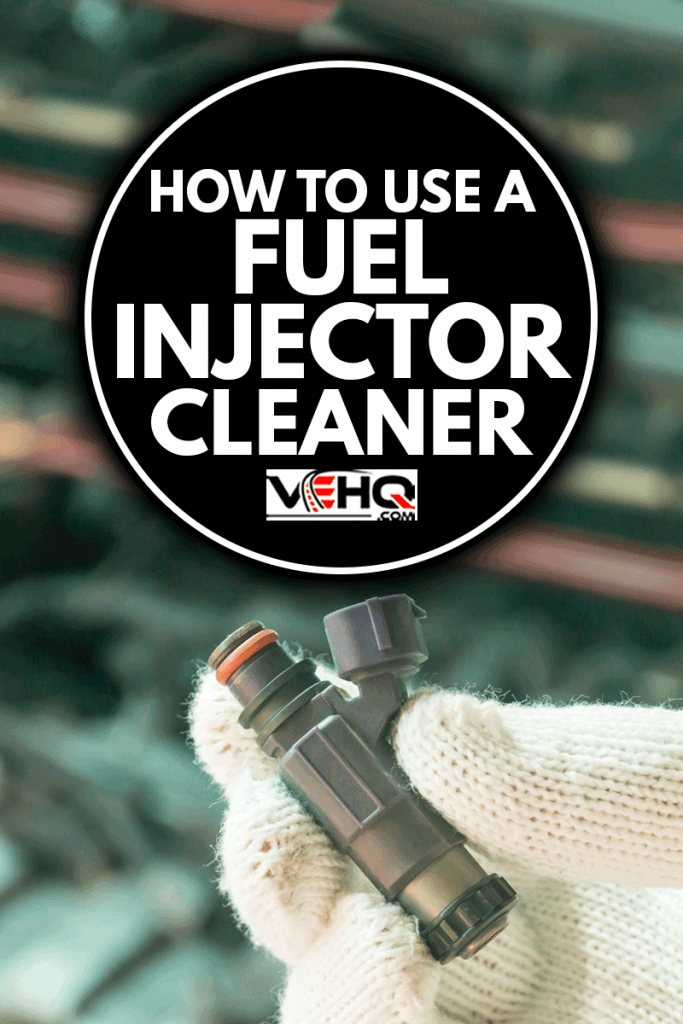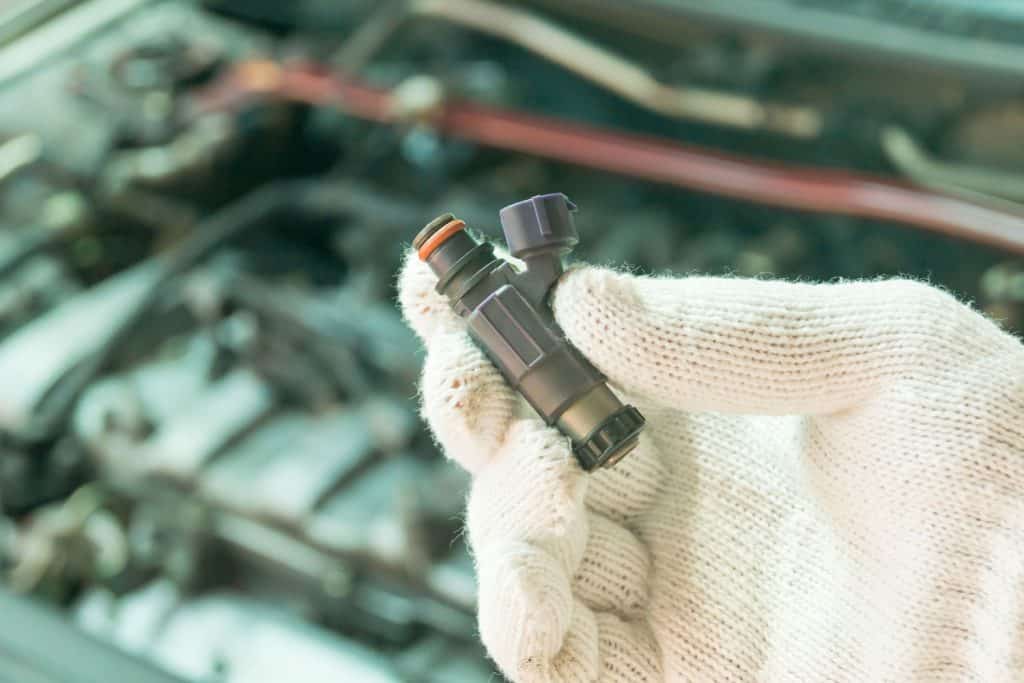Using a fuel injector cleaner is one of the simplest ways to protect your vehicle and improve its performance. A clean fuel system can increase gas mileage, improve engine efficiency, and keep your car running smoothly. Using fuel injector cleaner keeps sludge from building up in your fuel system, which could cause major problems down the road. So, how do you use fuel injector cleaner? We've done the research, and we have the answers for you!
Follow these simple steps to use fuel injector cleaner:
- Select the product that works best for your vehicle.
- Determine how much fuel injector cleaner to use in your vehicle.
- Pour the appropriate amount of fuel injector cleaner into the fuel tank.
- Fill the vehicle's tank with fuel.
In the remainder of this article, we'll tell you how to select the right fuel injector cleaner for your vehicle and how to use it. We will also explain when you should use fuel injector cleaner, how much to use, and how long it takes for you to see results after you put it in your tank. Keep reading to learn everything you need to know about using fuel injector cleaner in your vehicle!

How To Use Fuel Injector Cleaner
1. Select The Fuel Injector Cleaner That Works Best For Your Vehicle
Selecting the product that is best suited to your vehicle is actually the most important -- and the most complex -- step in the process of using fuel injector cleaner. There are literally dozens of fuel injector cleaners on the market. Some are designed for use in gasoline engines, others for diesel systems. Some provide extra features like engine lubrication or fuel stabilization. Others work best with older engines, turbo-charged engines, or catalytic converters.
The Three Ps
All fuel injector cleaners contain one or more of three chemical compounds: polyether amine (PEA), polyisobutylene (PIB), and polyisobutylene amine (PIBA). Don't worry if you can't pronounce their names -- here's what each of them does for your vehicle's engine:
- Polyether amine (PEA) is a powerful nitrogen-based detergent that dissolves solid debris in the fuel lines, fuel injectors, and combustion chamber. If your engine has substantial buildup in the fuel system -- indicated by decreased gas mileage, slow acceleration, or rough idling -- choose a fuel injector cleaner that contains PEA.
- Polyisobutylene (PIB) works with both gasoline and diesel engines. It removes sludge from the fuel system and is particularly good at eliminating the trace amounts of water that can cause a fuel tank to rust.
- Polyisobutylene amine (PIBA) is a mild detergent that is best for maintaining clean fuel lines, fuel injectors, and combustion chamber, rather than for eliminating existing debris and sludge.
Many fuel injector cleaners contain all three of these compounds, in varying ratios. Read the labels carefully and narrow your options to those products that best suit the condition of your vehicle's fuel system.
Gas, Diesel, Ethanol, Or Biodiesel
The next question you should ask when selecting a fuel injector cleaner is: "What type of fuel system does this product work with?" Many fuel injector cleaners work only in gas engines, while others can be used in both gasoline and diesel systems. A few, like the Sea Foam Motor Treatment shown below, are effective in gas, diesel, ethanol, and biodiesel engine systems.
If your vehicle uses traditional gasoline, purchasing one of these multi-system cleaners will not give you better results. However, if you use diesel, biodiesel, or ethanol-based fuel, it's critical that you select a fuel injector cleaner that's designed for your vehicle's fuel system.
Click here for Sea Foam Motor Treatment on Amazon.
Basic Fuel System Cleaning
Once you've determined which fuel injector cleaners are compatible with your vehicle's engine, you can narrow the field of available options by determining whether you want the product to simply clean the fuel system or to also provide other services, such as engine lubrication and/or fuel stabilization.
Basic fuel injector cleaners, such as the Gumout product depicted below, are the least expensive option. They work like detergents, dissolving buildup in the fuel lines, injectors, and combustion chamber.
Click here for Gumout basic fuel injector cleaner on Amazon.
Cleaning Plus Lubrication
Some fuel injector cleaners provide not only basic fuel system cleaning but also lubrication of the engine. Products like Red Line SI-1 Complete Fuel System Cleaner, often called 3-in-1 fuel injector cleaners, dissolve impurities in the fuel lines and injectors, get rid of carbon buildup in the combustion chamber, and lubricate the cylinders, allowing you to use lower-octane gas without losing performance.
Click here for Red Line SI-1 fuel system cleaner on Amazon.
Cleaning, Lubrication, And Fuel Stabilization
The most expensive products in this class provide not only fuel system cleaning and engine lubrication, but also fuel stabilization. These "5-in-1" fuel system cleaners are excellent choices if your vehicle sits for long periods of time between uses. Although they are most often used in boats, they are great for cars and trucks that are not driven regularly. Using 5-in-1 products in your vehicle reduces emissions, provides a smoother ride, and improves gas mileage and horsepower.
Click here for Royal Purple Max Clean on Amazon.
Other Considerations
If your car's engine is turbocharged or uses a catalytic converter, it will be incompatible with many brands of fuel injector cleaner. Make sure to read the manufacturer's label carefully. It may also be a good idea to consult your Owner's Manual and/or talk with your mechanic to determine which product will be best for your vehicle.
Click here for Chevron Techron Complete Fuel System Cleaner on Amazon.
2. Determine How Much Fuel Injector Cleaner To Use In Your Vehicle
Once you've chosen the fuel injector cleaner that's ideal for your engine, read the product's label thoroughly to determine how much to use in your vehicle. A typical ratio is one ounce of cleaner for every gallon of gas tank capacity: so, for example, 15 ounces of fuel injector cleaner for a 15-gallon gas tank.
However, many fuel injector cleaners come in 12- or 20-ounce containers and are designed to work with a range of gas tank sizes. If you've purchased one of these products and your gas tank falls within its specified size range, you simply pour the whole bottle of fuel injector cleaner into your gas tank.
3. Pour Fuel Injector Cleaner Into The Fuel Tank
Now that you've chosen a fuel injector cleaner and determined how much to use, the rest of the process is easy! Wait until the fuel level in your tank is low; then take your car to a gas station. Open the gas cap and simply pour the appropriate amount of fuel injector cleaner directly into the gas tank.
Most fuel injector cleaners are packaged in plastic bottles with long nozzles that make it easy to get the fluid into your tank with no drips or spills; if the product you are using does not have this feature, take along a small funnel and use it to ensure a clean pour.
4. Fill The Vehicle's Tank With Fuel
After you've poured the right amount of fuel injector cleaner into your gas tank, fill up the tank with fuel; then replace the gas cap, and you're ready to go! The fuel injector cleaner, now mixed with the fuel in your vehicle's tank, will do its job as you drive.
As it works its way through your vehicle's fuel lines, fuel injectors, and combustion chamber, the fuel injector cleaner will act like a detergent, "scrubbing" away the buildup of sludge in your fuel system. You should notice increased gas mileage, better acceleration, and smoother idling.
When Should You Use Fuel Injector Cleaner?
The answer to this question depends on the condition of your engine and the specifications of the fuel injector cleaner. Most mechanics recommend that you use a fuel injector cleaner every 1,500 to 3,000 miles. You may want to use it more often if your vehicle's engine is older or if you are looking to optimize its performance.
Never use fuel injector cleaner in an engine with less than 10,000 miles on it. There will be no buildup on an engine this new, and the detergent can damage the metal parts of the fuel system.
Do You Put Fuel Injector Cleaner In Before Or After Gas?
It's best to put fuel injector cleaner into your gas tank before you add gas. Ideally, wait until your gas tank is nearly empty (1/8 tank or less); then take your vehicle to a gas station, pour the fuel injector cleaner into the tank, and immediately fill the tank with fuel. This allows the fuel and the cleaner to mix thoroughly with each other, so your vehicle's fuel system will get a steady dose of the cleaning agent throughout the entire tank of gas.
Can I Put Fuel Injector Cleaner In Half A Tank?
While you can put fuel injector cleaner into a half-tank -- or even a full tank -- of gas, this is not recommended, because the fuel and the cleaner will not mix optimally.
Ideally, you should pour fuel injector cleaner into a nearly empty tank; then, as you fill the tank with gas, the agitation caused by the fuel spewing in will distribute the cleaner evenly throughout the tank. If you must put fuel injector cleaner in a half-tank of gas, fill the tank immediately afterward to achieve at least some mixing of the cleaner and the fuel.
Can I Use Fuel Injector Cleaner Every Time I Fill Up?
Using fuel injector cleaner with every fill-up is probably a bit of overkill. Remember that motor vehicle fuels all have detergents added to them already, preventing much of the sludge buildup that used to plague cars' fuel systems.
It's best to follow the directions on your bottle of fuel injector cleaner, and use the product only as specified by its manufacturer. That said, if you are determined to use fuel injector cleaner every time you fill the gas tank, choose a mild product that won't harm your vehicle's engine from overuse.
Can You Put Too Much Fuel Injector Cleaner In Your Car?
Although fuel injector cleaner is basically a harmless detergent, it is possible to overdo a good thing. If you use more than the recommended amount, the chemicals in the cleaner can damage the lining of your fuel tank. And, if you use the product more often than recommended (for example, if you use a strong detergent with every fill-up), it can break down the seals, gaskets, and other rubber parts in your fuel system. For the health of your vehicle's engine, use fuel injector cleaner exactly as specified on its product label.
How Long Does It Take Fuel Injector Cleaner To Work?

Fuel injector cleaner starts working as soon as the treated gas begins flowing through the fuel system. However, you will not notice a difference in your vehicle's performance right away. The detergent needs time to gradually scrub away the buildup in the fuel system. You should see results after about 100 miles, and a significant difference in performance after a whole tank.
Once you've added fuel injector cleaner and filled the tank with gas, try not to fill up again until your tank is nearly empty. Otherwise, the additional gas will dilute the cleaner and render it less effective.
In Closing
Using fuel injector cleaner is an easy and inexpensive way to maintain your vehicle's fuel system. Use the guidelines above to determine which product is the best for your vehicle. Then just add the appropriate amount to a nearly empty tank every 1,500 to 3,000 miles, and fill up with gas. You'll quickly see better gas mileage, improved acceleration, and a smoother ride!
You may also enjoy:





